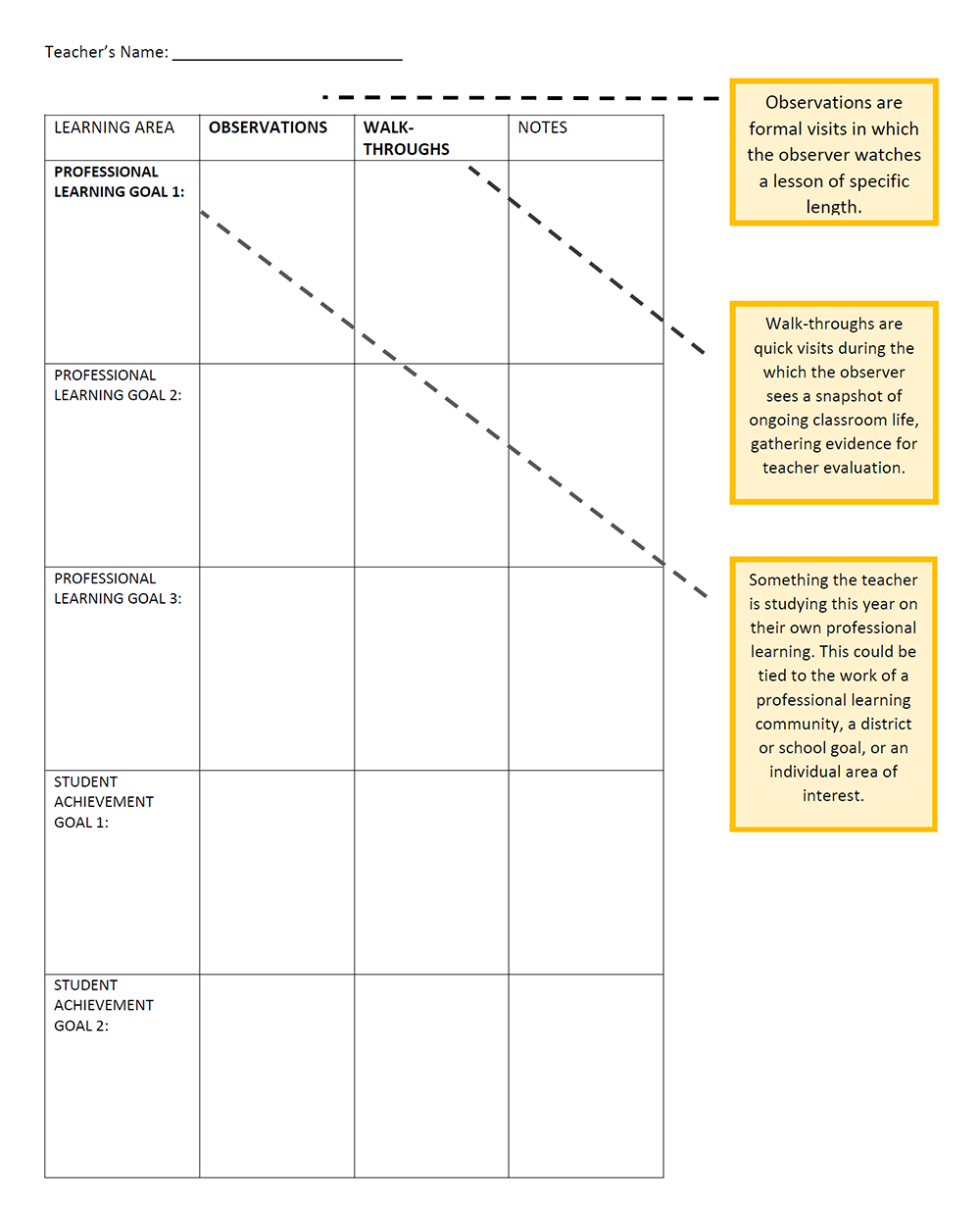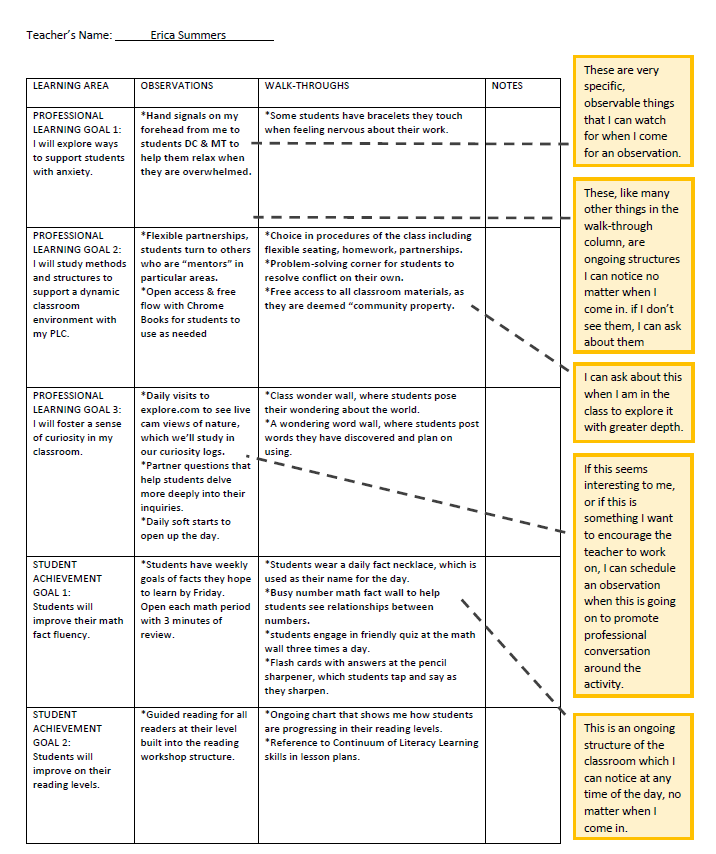
In a world of education that’s crowded by acronyms that vary state by state, teachers often find themselves needing to comply with mandates that someone far away has imposed on them. Sometimes, teachers look to principals for support in either doing away with these mandate (usually, we can’t!), or to help make sense of them, fitting them into our already too busy school days.
In a world of education that’s crowded by acronyms that vary state by state, teachers often find themselves needing to comply with mandates that someone far away has imposed on them. Sometimes, teachers look to principals for support in either doing away with these mandate (usually, we can’t!), or to help make sense of them, fitting them into our already too busy school days.
One way that we in the role of leadership can support our teachers is to co-construct teachers’ learning lives with them early in the year, to fit those mandates in with relevance and coherence. Here is an outline of a three-step plan that can make this happen:
Establish Learning Goals
Talk to each teacher early in the year about his or her own professional growth. Set goals that matter. You might start your conversation off with questions that prioritize the teacher’s perspective and values, such as:
- What are you ready for?
- How will you extend the professional learning you did last year?
- What’s next for you?
- What would you like to study this year (maybe together with some colleagues?)
This can start the conversation off, and you and the teacher can imagine what new goals might make the upcoming year an exciting one for the teacher as a learner. Dovetail each goal with questions that sketch out how the teacher will be supported in achieving these goals, such as:
- How can I help you in this study?
- What structures at school (like observations, walk-through’s, coaching, PLC’s) can we use to further your study?
Support Professional Learning Around Teacher Interest
Once teachers decide on their learning goals, you can craft some of their learning opportunities around those goals. For example, if a teacher decides that she’d like to study conferring in the reading workshop that can be a focus for an instructional coach. Even goals that are more about social emotional learning than about curriculum can be addressed in conjunction with professional learning: if a teacher is studying ways to support students with anxiety, it can be something you study tangentially within your coaching time together.
Another way to integrate teachers’ goals into their professional learning across the year is to find teachers who are studying similar things, and group them together in a PLC (professional learning community). Here are some tips in making these groups as relevant as possible to teachers’ learning goals:
- Create time for PLC’s to meet. If it’s possible to have longer stretches of time during the school day, try to orchestrate that. You may need some subs sometimes, or arrange some other creative scheduling, but if teachers see that you’re willing to work with them to give them longer chunks of time where they can work with students during their study group about something that matters to them, they’ll more likely amaze you with their learning.
- Engineer curiosity through essential questions. Encourage teachers during their first PLC meeting to craft essential questions that will guide their study month by month. Suggesting that they post their essential questions publicly can spark conversation among anyone who walks by. As they uncover new knowledge about each question, they can post their ideas right under them.
- Encourage reflection with teachers in groups and individually, in formal one-on-one meetings or informally in the hallway as you walk by.
Use Teacher Learning as the Lens for Teacher Evaluation
You can add some supervisory capital to this process by making teachers’ learning goals a part of the various elements of the teacher evaluation process. Bring their goals into observations, walk-through’s, and anything else that you have to do. By doing so, you’ll see at least two positive effects:
- It will add weight to the observations and other evaluation tools you use, because teachers will be dealing with content they care about.
- It will be a way for teachers to tackle something that’s their choice, so the observation will be more of a learning opportunity, instead of the almost ceremonial show that it can sometimes become.
Don’t forget…when bringing in something teachers care about into an evaluative setting, keep it positive. Instead of coming in to “check up on” conferring or whatever the teacher may be studying, ask the teacher to tell you what they would like to highlight from their own learning in the lesson you’ll be watching.
|
DON’T SAY |
INSTEAD SAY |
|
I know you’ve been working on ____. Let’s see that. |
You’ve been working really hard on ____. What part of that are you proud of that I might see? |
|
What evidence do you have of this learning goal? |
How can this observation (or walk-through) highlight some things you’re really proud of? |
|
Here’s what I noticed about _____. You should try looking at it like this… |
What type of feedback about _____ would you find most helpful during or after this observation? |
Since the work of professional learning is very deep and nuanced, you yourself may not realize all the tiny details of what teachers are applying when you visit during an observation or a walk-through. This streamlining document is something teachers can fill out early in the year, and continually update as new learning happens. For example, one of the PLC’s in our school studied ways to support students with anxiety. Teachers kept brainstorming very smart, yet very subtle structures to support kids, including special bracelets that can help kids when they worry in class. An observer may not notice a particular child touching a bracelet during an observation when the work becomes difficult. By pointing it out on this sheet, I can make sure to pay attention to the work the teacher has done. By doing so, I validate the teacher’s learning, and the observation itself becomes a much more positive experience.
 When we put teacher learning at the heart of what we do, we make the many hoops we must jump through as teachers and leaders much more meaningful, and part of a longer journey toward professional growth.
When we put teacher learning at the heart of what we do, we make the many hoops we must jump through as teachers and leaders much more meaningful, and part of a longer journey toward professional growth.
…
Learn more about Reclaiming the Principalship at Heinemann.com
 Follow us on Instagram @heinemannpub to stay up to date on the latest books, your favorite authors, and upcoming events!
Follow us on Instagram @heinemannpub to stay up to date on the latest books, your favorite authors, and upcoming events!

Tom Marshall is a former teacher and staff developer at the Teachers College Reading and Writing Project. He is currently the principal of Stony Lane Elementary School in Paramus, New Jersey. Tom runs a course for literacy coaches from around New Jersey, coordinates the Littogether Teacher Leader Project, and is the founder of the New Jersey Literacy Leaders' Network, a learning group of over 150 educational leaders who meet to study ways to supervise and support best practices in literacy instruction. You can find him online at http://www.littogether.com and on twitter at @TomLitTogether


